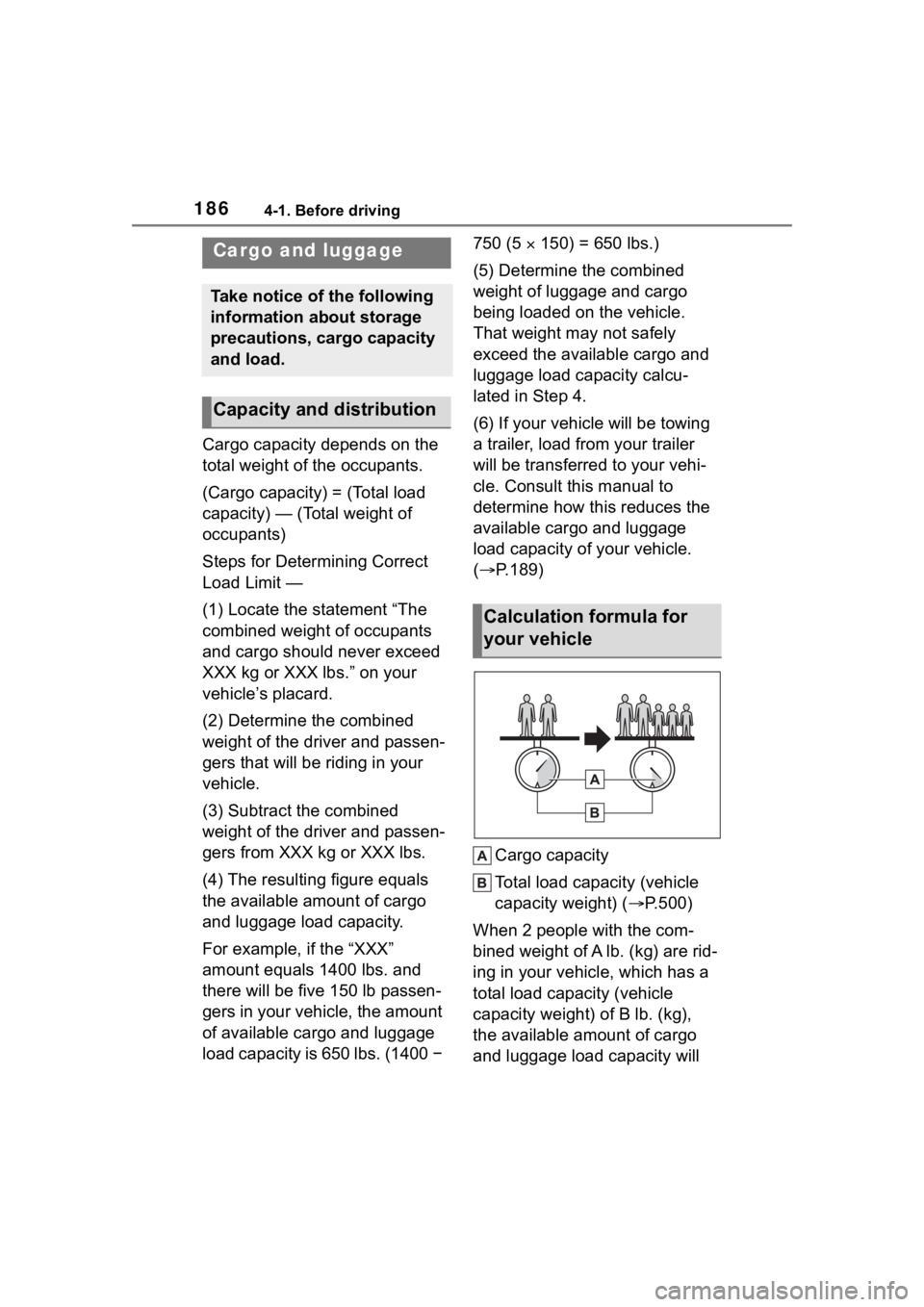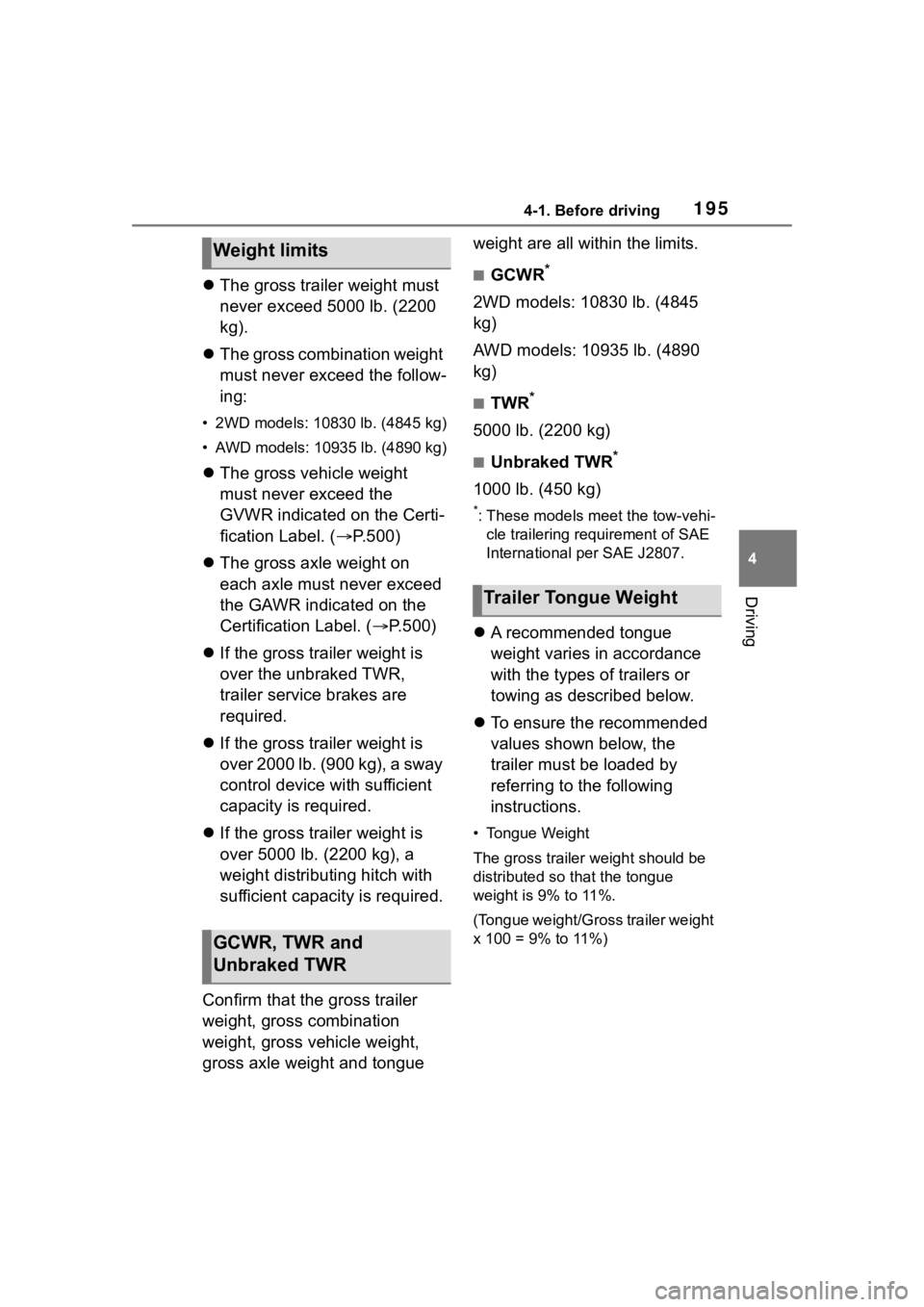towing capacity TOYOTA HIGHLANDER 2022 Owners Manual
[x] Cancel search | Manufacturer: TOYOTA, Model Year: 2022, Model line: HIGHLANDER, Model: TOYOTA HIGHLANDER 2022Pages: 568, PDF Size: 13.73 MB
Page 186 of 568

1864-1. Before driving
Cargo capacity depends on the
total weight of the occupants.
(Cargo capacity) = (Total load
capacity) — (Total weight of
occupants)
Steps for Determining Correct
Load Limit —
(1) Locate the statement “The
combined weight of occupants
and cargo should never exceed
XXX kg or XXX lbs.” on your
vehicle’s placard.
(2) Determine the combined
weight of the driver and passen-
gers that will be riding in your
vehicle.
(3) Subtract the combined
weight of the driver and passen-
gers from XXX kg or XXX lbs.
(4) The resulting figure equals
the available amount of cargo
and luggage load capacity.
For example, if the “XXX”
amount equals 1400 lbs. and
there will be five 150 lb passen-
gers in your vehicle, the amount
of available cargo and luggage
load capacity is 650 lbs. (1400 − 750 (5
150) = 650 lbs.)
(5) Determine the combined
weight of luggage and cargo
being loaded on the vehicle.
That weight may not safely
exceed the available cargo and
luggage load capacity calcu-
lated in Step 4.
(6) If your vehicle will be towing
a trailer, load from your trailer
will be transferred to your vehi-
cle. Consult this manual to
determine how this reduces the
available cargo and luggage
load capacity of your vehicle.
( P.189)
Cargo capacity
Total load capacity (vehicle
capacity weight) ( P.500)
When 2 people with the com-
bined weight of A lb. (kg) are rid-
ing in your vehicle, which has a
total load capacity (vehicle
capacity weight) of B lb. (kg),
the available amount of cargo
and luggage load capacity will
Cargo and luggage
Take notice of the following
information about storage
precautions, cargo capacity
and load.
Capacity and distribution
Calculation formula for
your vehicle
Page 192 of 568

1924-1. Before driving
WARNING
■Trailer towing precautions
To tow a trailer safely, use
extreme care and drive the vehi-
cle in accordance with the trailer’s
characteristics and operating con-
ditions. Failure to do so could
cause an accident resulting in
death or serious injury. Vehicle
stability and braking performance
are affected by trailer stability,
brake setting and performance,
and the hitch. Your vehicle will
handle different ly when towing a
trailer.
■To avoid accident or injury
●Do not exceed the TWR,
unbraked TWR, GCWR, GVWR
or GAWR.
●If the gross trailer weight is over
2000 lb. (900 kg), a sway con-
trol device with sufficient capac-
ity is required.
●If the gross trailer weight is over
5000 lb. (2200 kg), a weight dis-
tributing hitch with sufficient
capacity is required.
●Adjust the tongue weight within
the appropriate range. Place
heavier loads as close to the
trailer axle as possible.
●Do not exceed 65 mph (104
km/h), the posted towing speed
limit or the speed limit for your
trailer as set fort h in your trailer
owner’s manual, whichever is
lowest. Slow down sufficiently
before making a turn, in cross
winds, on wet or slippery sur-
face, etc. to help avoid an acci-
dent. If you experience a
vehicle-trailer instability from
reducing a certain speed, slow
down and make sure you keep
your vehicle speed under the
speed of which you experience
the instability.
●Do not make jerky, abrupt or
sharp turns.
●Do not apply the brakes sud-
denly as you may skid, resulting
in jackknifing and loss of vehicle
control. This is especially true
on wet or slippery surfaces.
●Do not exceed the trailer hitch
assembly weight, gross vehicle
weight, gross axle weight and
trailer tongue w eight capacities.
●Do not use the following sys-
tems when trailer towing.
• Dynamic radar cruise control with full-speed range
• LTA (Lane Tracing Assist)
• PCS (Pre-Collision System)
• BSM (Blind Spot Monitor) (if equipped)
●Slow down and downshift
before descending steep or long
downhill grades. Do not make
sudden downshifts while
descending steep or long down-
hill grades.
●Vehicle-trailer instability is more
likely on steep long downhills.
Before descending steep or
long downhill grades, slow
down and downshift. Do not
make sudden downshifts when
descending steep or long down-
hill grades. Avoid holding the
brake pedal down too long or
applying the brakes too fre-
quently. This could cause the
brakes to overheat and result in
reduced braking efficiency.
●Vehicles with a compact spare
tire: Do not tow a trailer when
the compact spare tire is
installed on your vehicle.
Page 195 of 568

1954-1. Before driving
4
Driving
The gross trailer weight must
never exceed 5000 lb. (2200
kg).
The gross combination weight
must never exceed the follow-
ing:
• 2WD models: 10830 lb. (4845 kg)
• AWD models: 10935 lb. (4890 kg)
The gross vehicle weight
must never exceed the
GVWR indicated on the Certi-
fication Label. ( P.500)
The gross axle weight on
each axle must never exceed
the GAWR indicated on the
Certification Label. ( P.500)
If the gross trailer weight is
over the unbraked TWR,
trailer service brakes are
required.
If the gross trailer weight is
over 2000 lb. (900 kg), a sway
control device with sufficient
capacity is required.
If the gross trailer weight is
over 5000 lb. (2200 kg), a
weight distributing hitch with
sufficient capacity is required.
Confirm that the gross trailer
weight, gross combination
weight, gross vehicle weight,
gross axle weight and tongue weight are all within the limits.
■GCWR*
2WD models: 10830 lb. (4845
kg)
AWD models: 10935 lb. (4890
kg)
■TWR*
5000 lb. (2200 kg)
■Unbraked TWR*
1000 lb. (450 kg)
*: These models meet the tow-vehi-
cle trailering requirement of SAE
International per SAE J2807.
A recommended tongue
weight varies in accordance
with the types of trailers or
towing as described below.
To ensure the recommended
values shown below, the
trailer must be loaded by
referring to the following
instructions.
• Tongue Weight
The gross trailer weight should be
distributed so that the tongue
weight is 9% to 11%.
(Tongue weight/Gross trailer weight
x 100 = 9% to 11%)
Weight limits
GCWR, TWR and
Unbraked TWR
Trailer Tongue Weight
Page 562 of 568

562Alphabetical Index
Warning light ........................ 460
Tire information ...................... 511 Glossary ............................... 515
Size ...................................... 513
Tire identification number ..... 512
Uniform Tire Quality Grading 514
Tire pressure display ............. 420
Tire pressure warning system Function ............................... 420
Initializing ............................. 423
Installing tire pressure warning valves and transmitters ...... 422
Registering ID codes ............ 426
Warning light ........................ 460
Tires Chains .................................. 325
Checking .............................. 417
If you have a flat tire ............. 471
Inflation pressure.................. 429
Information ........................... 511
Replacing ............................. 471
Rotating tires ........................ 419
Size ...................................... 505
Snow tires ............................ 324
Spare tire.............................. 471
Tire inflation pressure display function............................... 420
Tire pressure warning system ........................................... 420
Warning light ........................ 460
Tools ........................................ 472
Top tether strap ........................ 62
Total load capacity ................. 500
To w i n g Dinghy towing....................... 201
Emergency towing................ 451
Trailer towing ........................ 190
Toyota Multi-operation touch 332
Toyota Safety Sense 2.5 + Automatic High Beam .......... 219
Dynamic radar cruise control with full-speed range .......... 257 LTA (Lane Tracing Assist) .....246
PCS (Pre-Collisio
n System) .235
RSA (Road Sign Assist) ........269
TRAC (Traction Control) ........318
Traction Control (TRAC) ........318
Trailer Sway Control ...............318
Trailer towing ..........................190
Transmission Automatic transm ission ........206
Driving mode select switch ... 311
If th e s hif t le ver ca n no t b e s hif te d from P .................................207
M mode ................................208
Trip meters ................................83
Turn signal lights Replacing light bulbs ............439
Turn signal lever ...................209
U
USB charging ports ................373
V
Vanity lights ............................383
Vanity mirrors .........................383
Vehicle data recording ...............7
Vehicle identification number500
Vehicle information display88, 97
Vehicle Stability Control (VSC)...............................................318
Ventilators (seat ventilators) .358
VSC (Vehicle Stability Control) ...............................................318
W
Warning buzzers ABS ......................................458
Airbags .................................457
Approach warning ................264
Brake hold ............................463
Brake Override System ........458